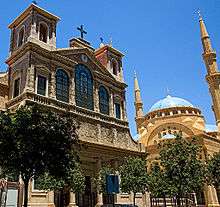St. George Maronite Cathedral, Beirut
| Saint George Maronite Cathedral | |
|---|---|
 | |
| Basic information | |
| Location | Beirut, Lebanon |
| Geographic coordinates | 33°53′43″N 35°30′19″E / 33.895272°N 35.505310°ECoordinates: 33°53′43″N 35°30′19″E / 33.895272°N 35.505310°E |
| Affiliation | Maronite Church |
| Country | Lebanon |
| Year consecrated | 1894 |
| Status | active |
| Architectural description | |
| Architect(s) | Giuseppe Maggiore |
| Architectural style | Neo-Classical |
| Groundbreaking | 1884 |
| Completed | 1894 |
| Specifications | |
| Direction of façade | South |
| Materials | Sandstone, marble, granite, limestone |
Saint George Maronite Cathedral (Arabic: كاتدرائية مار جرجس للموارنة) is the cathedral of the Maronite Catholic Archeparchy of Beirut, Archdiocese of the city of Beirut, Lebanon. Its construction, with a Neoclassical facade, interior and plan inspired by the Basilica di Santa Maria Maggiore, began in 1884 and ended in 1894.
The cathedral was heavily hit and shelled during the Lebanese civil war and was plundered and defaced. A number of works of art that were looted have since been recovered, including the famous painting by Delacroix representing Saint George, the patron saint of the cathedral and of the Archdiocese of the city of Beirut. The cathedral was restored after the end of the hostilities and was re-inaugurated by the Maronite Patriarch Nasrallah Boutros Sfeir on 24 April 2000.[1]
Construction

The Cathedral of Saint George was built by Monsignor Joseph Debs, the Archbishop of Beirut, on the site of an earlier church that was also dedicated to the same saint. The earlier structure was built in 1755 to serve the Maronites of Beirut.[2] Work began in 1884 using Roman columns from the temple of Deir El Qalaa in Beit Mery.[3] The edifice was completed and consecrated on Palm Sunday in 1894. Built on the plan of a basilica with its nave and two lateral aisles separated by two rows of columns, the cathedral has a façade of neo-classical style designed by Italian architect Giuseppe Maggiore. The interior bears a general resemblance to that of Santa Maria Maggiore in Rome.[4]
The nave is covered with a coffered ceiling with gilded and a double wooden structure, covered with golden leaves on a beige background. The walls are decorated with stucco and marble. Above the main altar is a canopy four columns. At the rear, in the choir, is the cathedra (bishop throne) of the Archbishop of Beirut, and the chair used by Pope John Paul II during his pastoral visit to Lebanon in 1997.[5]
Architecture
Inspired by the Basilica of Santa Maria Maggiore in Rome, Saint George Maronite Cathedral was built between 1884 and 1894, and inaugurated by Bishop Youssef Debs. Prior to this, the Maronite community of Beirut had made use of a small church that stood nearby and dated back to 1753. In 1954, engineer Antoun Tabet undertook restoration works inside the cathedral. Originally planned in the shape of a cross, its transept was shortened and arches added at either end. Badly damaged during the Lebanese Civil War (1975-1990), the cathedral was completely rehabilitated by 1997, recovering its original Renaissance cruciform shape. It was inaugurated in April 2000. Beneath the forecourt of the cathedral’s annex, significant archaeological remains have been unearthed and preserved. They include a Hellenistic structure, part of the Roman Decumanus Maximus colonnaded street, and an Ottoman wall.
On 19 November 2016, Beirut Archbishop Paul Matar inaugurated the new campanile which took a decade to construct. The campanile stands 72 meters (236 ft) high; the original design envisaged a 75 meters (246 ft) tall bell tower to match the height of the campanile of the Santa Maria Maggiore basilica in Rome. According to the archbishop, the reduction in the campanile's height to stand equal to that of the minarets of the adjacent Mohammad Al-Amin Mosque aims to send a message of interfaith solidarity and harmony.[6]
Location
The Church of Saint George is located in the downtown area of Beirut. It is one of the most important religious buildings of the city. Right next to her is the Sunni Mohammad Al-Amin Mosque. About eighty meters north is the Saint George Greek Orthodox Cathedral of the Greek Orthodox Church of Antioch.
Timeline
1884-1894: Construction of the Cathedral, which was inspired by the Basilica Santa Maria Maggiore in Rome.
1954: Restoration works inside the cathedral undertaken by Antoun Tabet.
1975-1990: Civil War badly damaged the cathedral.
1997: Post war rehabilitation of the Cathedral led to the recovery of its original Renaissance cruciform shape. Significant archaeological remains were unearthed and preserved.
April 2000: Cathedral inauguration.
19 November 2016: Campanile inauguration.[6]
See also
- Beirut Central District
- Maronite Church
- Maronite Christianity in Lebanon
- Christianity in Lebanon
- Basilica di Santa Maria Maggiore
- Garden of Forgiveness
Further reading
- Tubiya ABI 'AD, Katidra'iya Mar Jirjis al-Maruniya, Beirut: Chahine Printing Press, 2000.
Sources
- Kassir, Samir (2003) Histoire de Beyrouth, Fayard, Paris. ISBN 2-213-02980-6, Les lieux de culte au Liban. Ministère du Tourisme, Beyrouth.
References
- ↑ Discover Lebanon. "Beirut Saint George Cathedral, Mosque El Omari". Retrieved 2009-12-27.
- ↑ Archdiocese of Beirut. "cathedrale". Archdiocese of Beirut. Archived from the original on September 11, 2007. Retrieved 2010-01-08. (in Arabic)
- ↑ Lebanese Ministry of Tourism. "Ministry of Tourism :: Destination Lebanon". Retrieved 2009-12-27.
- ↑ [Vloeberghs, Ward (2008), http://www.uclouvain.be/cps/ucl/doc/epl-corta/documents/RSCAS_2008_17.pdf, PDF). ISSN 1028-3625. Retrieved 2010-01-13.]
- ↑ [Morel, Elodie. "The places of worship in Down-Town: a gleam of diversity". iloubnan. Retrieved 2010-01-08.]
- 1 2 Perry, Tom (23 November 2016). "Beirut skyline captures religious rivalry and harmony". Reuters. Retrieved 12 December 2016.